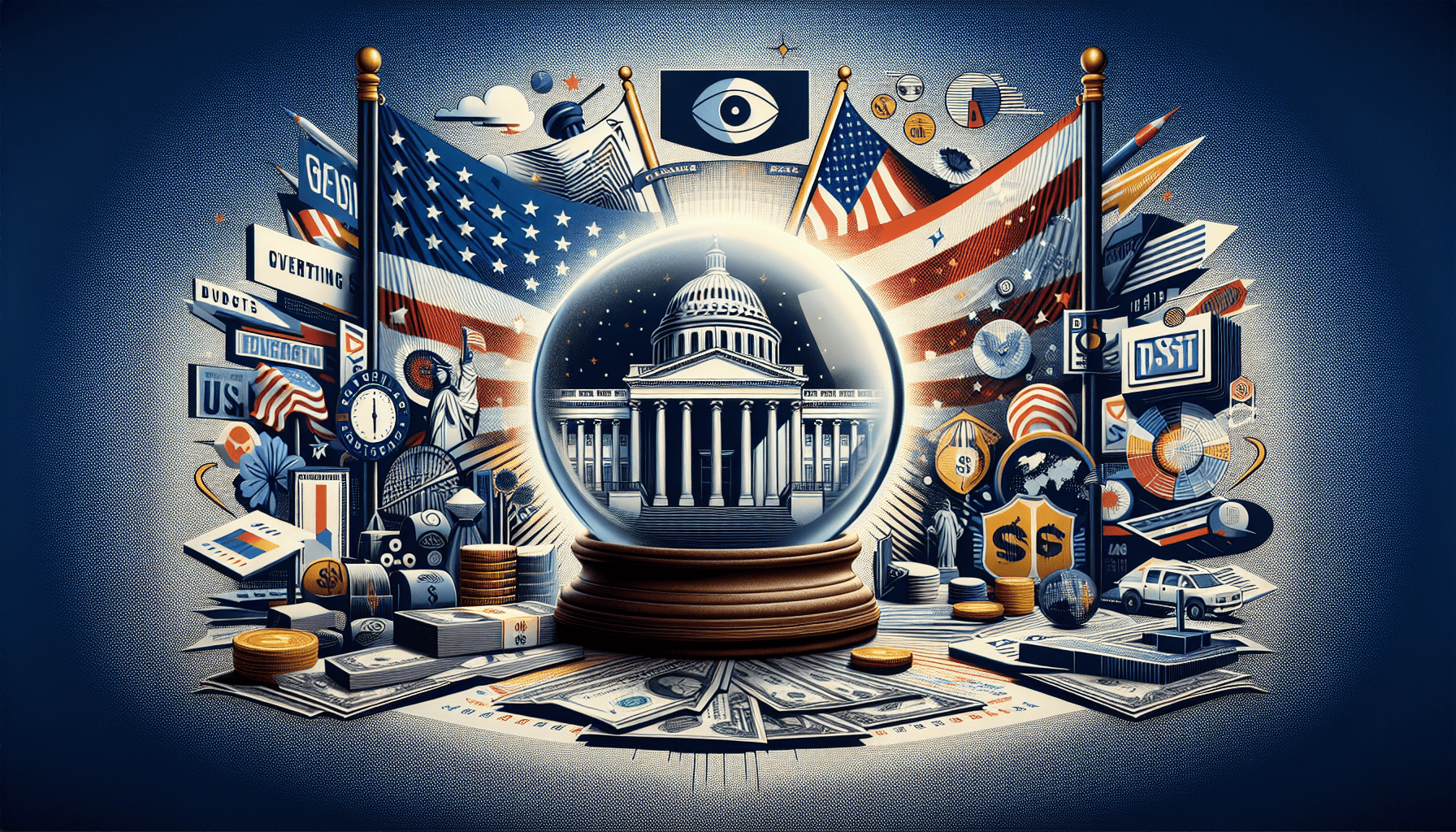Have you ever wondered how the US national debt is projected and monitored? Well, the Congressional Budget Office (CBO) is the key player in this realm. As an independent agency established by Congress, the CBO plays a crucial role in analyzing and projecting the nation’s finances. By using its expertise and analysis, the CBO provides valuable insights into the future trajectory of the US national debt, helping policymakers make informed decisions. In this article, we will explore the significant role that the Congressional Budget Office plays in projecting the US national debt and its impact on the country’s economic landscape.
Understanding the Congressional Budget Office
The Congressional Budget Office (CBO) is an independent agency of the United States federal government that provides non-partisan analysis and information on budgetary and economic issues. It was established in 1974 as a result of the Congressional Budget and Impoundment Control Act, which aimed to improve Congress’s ability to evaluate the economic and budgetary impact of legislation.
History and establishment
The establishment of the CBO was a significant milestone in the evolution of the budget process in the United States. Prior to its creation, the power to set budgetary priorities and estimate the financial impact of proposed legislation rested primarily with the executive branch. The CBO was created to provide Congress with an independent and objective assessment to inform its decision-making process.
Purpose and function
The primary purpose of the CBO is to assist Congress in understanding the budgetary implications of policy decisions. It plays a crucial role in the legislative process by providing cost estimates, economic analysis, and budgetary forecasts. By providing objective and non-partisan information, the CBO helps policymakers make informed decisions based on accurate and reliable data.
Organizational structure
The CBO is headed by the Director of the Congressional Budget Office, who is appointed by the Speaker of the House of Representatives and the President Pro Tempore of the Senate. The Director is responsible for leading the agency and overseeing its operations. The CBO consists of several divisions, including the Budget Analysis Division, the Economic Analysis Division, and the Health, Retirement, and Long-Term Analysis Division. These divisions work together to provide comprehensive analysis and forecasts.
The authority and role of The Director of the Congressional Budget Office
The Director of the Congressional Budget Office holds significant authority and is responsible for ensuring the objectivity and quality of the analysis provided by the agency. The Director serves as a crucial link between Congress and the executive branch, providing guidance on policy matters and ensuring the accuracy and reliability of the agency’s work. The Director also represents the CBO in interactions with Congress, the media, and other stakeholders.
Role of Congressional Budget Office in Budget Process
The Congressional Budget Office plays a crucial role in the budget process by providing analysis and information that assists in the evaluation of the President’s budget requests, estimation and forecasting of budgetary matters, provision of economic data, and scoring legislative proposals.
Analyzing the President’s budget requests
One of the primary responsibilities of the CBO is to analyze the budget proposals put forward by the President. The CBO reviews these proposals and provides a comprehensive analysis of their potential impact on the budget, economy, and various sectors. This analysis helps Congress in determining the feasibility and potential consequences of the proposed budgetary measures.
Estimation and forecasting roles
The CBO is responsible for estimating and forecasting budgetary matters, such as revenue and spending levels. It uses sophisticated economic models and data analysis to project future trends and inform policymakers about potential budgetary outcomes. This forecasting plays a vital role in long-term planning and decision-making.
Provision of economic data and forecasting
In addition to budgetary matters, the CBO also provides economic data and forecasts to Congress. This includes information about economic growth, inflation, employment, and other key indicators. By providing such data, the CBO helps policymakers understand the broader economic context in which budgetary decisions are made and formulate effective policies.
Scoring legislative proposals
The CBO scores legislative proposals by evaluating their budgetary impact. This involves estimating the costs and savings associated with proposed legislation. The “score” provided by the CBO helps Congress evaluate the fiscal impact of different policy options and prioritize their considerations accordingly.

Congressional Budget Office and Debt Prediction
Predicting the US national debt is an essential aspect of the Congressional Budget Office’s work. Understanding the basis for debt prediction, the factors considered in predictions, the mechanisms for long-term debt projection, and the role of Congress in debt prediction processes is crucial for evaluating the CBO’s role in this area.
Basis for debt prediction
The CBO’s debt predictions are based on a comprehensive analysis of various factors that impact the federal budget. This includes an assessment of projected revenues, spending levels, economic growth, interest rates, and demographic trends. By analyzing these variables, the CBO can estimate the expected trajectory of the national debt.
Factors considered in predictions
When making debt predictions, the CBO takes into account a wide range of factors. These include changes in fiscal policy, economic conditions, demographic trends, and other relevant variables. The CBO’s models incorporate data from various sources and apply rigorous analytical techniques to generate accurate predictions.
Long-term debt projection mechanisms
The CBO uses long-term debt projection mechanisms to forecast the future trajectory of the national debt. These mechanisms include detailed analysis of the budgetary impact of existing laws and policies, as well as assessments of potential changes in fiscal policy, economic conditions, and demographics. By taking a comprehensive approach to debt projection, the CBO provides policymakers with valuable information for long-term planning.
Role of Congress in debt prediction processes
Congress plays a significant role in the debt prediction processes of the CBO. By enacting legislation and making policy decisions, Congress directly influences the level and trajectory of the national debt. The CBO’s debt predictions provide valuable information to Congress, helping lawmakers understand the consequences of different policy choices and make informed decisions to manage the national debt.
Impact of Congressional Budget Office Projections on Policy Making
The Congressional Budget Office’s projections have a significant impact on policy making at both the legislative and executive levels. These projections influence fiscal policies, affect spending decisions, guide the setting of tax policies, and contribute to the formulation of economic recovery strategies.
Influencing fiscal policies
The CBO’s projections shape fiscal policies by providing policymakers with insights into the potential consequences of different policy choices. By highlighting the budgetary impact of proposed legislation and offering alternative scenarios, the CBO helps Congress and the executive branch make informed decisions about revenue generation, spending priorities, and deficit reduction strategies.
Affect on spending decisions
The CBO’s projections of future spending levels play a crucial role in shaping spending decisions. By providing analysis and forecasts of future spending trends, the CBO enables policymakers to make educated choices about budget allocations. This information helps guide discussions on funding for various programs, agencies, and initiatives.
Guide to setting tax policies
The CBO’s projections of revenue levels inform the setting of tax policies. By estimating future tax revenues, the CBO helps policymakers understand the potential impact of tax changes on the budget and the economy. This information assists Congress in crafting tax legislation that aligns with broader budgetary goals.
Formulation of economic recovery strategies
During times of economic crisis or recession, the CBO’s projections contribute to the formulation of economic recovery strategies. By assessing the potential fiscal impact of different policy options, the CBO provides policymakers with valuable insights into the effectiveness and feasibility of various measures. This helps guide decisions on stimulus packages, monetary policy, and other measures aimed at promoting economic recovery.

Analyzing the Accuracy of Congressional Budget Office Projections
The accuracy of the Congressional Budget Office’s projections has been a subject of scrutiny and debate. Analyzing its historical accuracy, comparing it with other predictions, understanding the factors that can cause deviations in projections, and exploring methods for improving accuracy are crucial for evaluating the reliability of the CBO’s projections.
Historical accuracy
The CBO’s projections have generally been regarded as reasonably accurate over the years. However, like any forecasting exercise, there will always be a degree of uncertainty surrounding projections. The CBO continuously assesses and refines its forecasting models to enhance the accuracy of its predictions.
Comparison with other predictions
The CBO’s projections are often compared with those made by other organizations, both within and outside the government. These comparisons help assess the reliability and robustness of the CBO’s forecasts. While there may be differences in specific projections, the CBO’s analysis is widely recognized for its systematic and rigorous approach.
Factors causing deviations in projections
Several factors can cause deviations in the accuracy of the CBO’s projections. These include unexpected economic shocks, changes in fiscal policy, unforeseen developments in the global economy, and unpredictable events such as natural disasters or pandemics. The CBO strives to incorporate these factors into its models but acknowledges the inherent uncertainty involved in making long-term predictions.
Methods for improving accuracy
To improve the accuracy of its projections, the CBO continuously reviews and improves its forecasting models. It seeks input from a wide range of experts, conducts research, and updates its methodologies based on evolving economic and budgetary trends. Additionally, the CBO actively engages in post-analysis of its projections to identify areas for improvement and refine its forecasting techniques.
Case Studies of Congressional Budget Office Projections
Examining specific case studies can provide insights into the accuracy and reliability of the Congressional Budget Office’s projections. Analyzing its projections during the 1990s economic recession, the 2008 Global financial crisis, and the 2020 Covid-19 pandemic-induced debt can help understand the challenges and complexities of forecasting accurately in different economic contexts.
1990s economic recession
During the 1990s economic recession, the CBO provided projections that helped guide policy decisions aimed at mitigating the impact of the recession. While some specific projections may have deviated from the actual outcomes, the CBO’s analysis provided a valuable framework for understanding the economic challenges and formulating appropriate policy responses.
2008 Global financial crisis
The CBO’s projections during the 2008 Global financial crisis were instrumental in informing policymakers about the severity of the crisis and the potential ramifications for the economy and the federal budget. Despite the complexity and uncertainty of the situation, the CBO’s analysis provided much-needed clarity and guided the formulation of policies aimed at stabilizing the financial system and preventing a deeper economic downturn.
2020 Covid-19 pandemic-induced debt
The Covid-19 pandemic and its economic consequences presented unique challenges for forecasting agencies like the CBO. The sudden and severe economic contraction required frequent updates and revisions of projections as new data became available. The CBO’s projections served as a crucial resource for policymakers, helping them understand the fiscal impact of the pandemic and make informed decisions about relief measures and stimulus packages.

Criticism and Challenges of Congressional Budget Office Debt Projections
The Congressional Budget Office’s debt projections have faced criticism, particularly regarding allegations of political bias, flaws in estimating models, and controversies related to transparency and openness. It is essential to examine these criticisms and challenges to assess the strengths and weaknesses of the CBO’s work.
Political bias allegations
The CBO has faced allegations of political bias, with some critics claiming that its projections tend to favor certain policy positions. However, the CBO is dedicated to maintaining its non-partisan status and takes significant steps to ensure objectivity and impartiality in its analysis. The agency follows rigorous methodologies and bases its projections on sound economic principles.
Flaws in estimating model
No forecasting model is perfect, and the CBO’s estimating models are subject to limitations and potential flaws. Some critics argue that these models may not adequately capture complex economic interactions or factor in all relevant variables. However, the CBO continuously reviews and refines its models to address these concerns and improve the accuracy of its projections.
Controversies related to transparency and openness
There have been controversies regarding the CBO’s transparency and openness. Some critics argue that the agency should provide more detailed information about its methodologies, assumptions, and data sources to allow for greater scrutiny and understanding of its projections. The CBO has taken steps to increase transparency, such as enhancing the accessibility of its reports and engaging with external reviewers and auditors.
Congressional Budget Office Response to Criticism
In response to criticism, the Congressional Budget Office has implemented measures to increase transparency, improve the accuracy of predictions, and open up to external audits and reviews. These initiatives aim to address concerns and enhance the credibility and effectiveness of the agency’s work.
Measures to increase transparency
The CBO has taken several measures to increase transparency, including publishing more detailed methodologies, expanding access to data and models used in projections, and improving the clarity and comprehensibility of its reports. By enhancing transparency, the CBO seeks to foster greater public trust and allow for informed scrutiny of its work.
Steps to improve the accuracy of predictions
The CBO is committed to continuously improving the accuracy of its predictions. It invests in research, evaluates feedback from experts, and assesses the performance of its forecasting models. By incorporating new data, refining methodologies, and learning from past experiences, the CBO strives to provide increasingly reliable projections.
Opening up to external audits and reviews
To enhance accountability and ensure the quality of its work, the CBO has initiated external audits and reviews of its operations. This includes inviting external experts to evaluate its methodologies, conduct independent assessments of its projections, and provide recommendations for improvement. By opening up to external scrutiny, the CBO demonstrates its commitment to transparency and the pursuit of excellence.

Comparing Congressional Budget Office with other Budgetary and Economic Bodies
Comparing the Congressional Budget Office with other budgetary and economic bodies provides insights into the similarities, differences, and unique roles played by these institutions. By contrasting it with the Federal Reserve, the Office of Management and Budget, and the Commission on Government forecasting, a comprehensive understanding of the CBO’s role can be attained.
Similarities and differences with Federal Reserve
While both the Congressional Budget Office and the Federal Reserve play crucial roles in informing economic decision-making, they have different responsibilities and areas of focus. The Federal Reserve is responsible for monetary policy, maintaining price stability, and promoting maximum employment, while the CBO focuses on budgetary and economic analysis and provides information to Congress for fiscal policy decisions.
Contrast with Office of Management and Budget
The Office of Management and Budget (OMB) is an agency within the executive branch responsible for assisting the President in the preparation of the federal budget and evaluating the performance of federal agencies. While the CBO provides non-partisan analysis and information to Congress, the OMB is involved in the policy-making process within the executive branch. Both institutions play important roles in the budget process but do so from different perspectives.
Comparisons with Commission on Government forecasting
The Commission on Government forecasting is an independent advisory body that provides analysis and recommendations on economic and budgetary matters. Unlike the CBO, the Commission does not have a direct role in the legislative process but focuses on providing expert guidance to policymakers. While both institutions contribute to informed decision-making, they operate with different mandates and structures.
The Future of Congressional Budget Office and Debt Projections
The future of the Congressional Budget Office and its debt projections is influenced by technological advancements, the evolving global economy, and changes in the political climate. These factors will shape the CBO’s methodologies, data sources, and forecasting techniques in the coming years.
Technological implications on prediction models
Technological advancements, such as enhanced data analytics, machine learning, and artificial intelligence, are likely to have a significant impact on the CBO’s prediction models. These advancements may enable the agency to incorporate a more extensive range of data sources, refine its models, and improve the accuracy and timeliness of its projections.
Effect of evolving global economy
The evolving global economy poses both opportunities and challenges for the Congressional Budget Office. As the global economy becomes increasingly interconnected, the CBO will need to consider the impact of global events, such as international trade, currency fluctuations, and geopolitical developments, on the US national debt. Adapting to the changing economic landscape will be crucial for accurate debt projections.
Changes in political climate and its impact
Changes in the political climate can have a profound impact on the Congressional Budget Office’s work. Shifts in policy priorities, changes in leadership, and alterations in the political landscape can influence the demand for specific types of analysis, the focus of projections, and the dynamics of the budget process. The CBO will need to navigate these changes while maintaining its commitment to objectivity and non-partisanship.
In conclusion, the Congressional Budget Office plays a vital role in the US budget process by providing objective analysis, cost estimates, and economic forecasts. Its debt projections inform policy decisions, guide fiscal policies, and contribute to long-term planning. While the accuracy of its projections has been subject to scrutiny, the CBO continuously strives to improve its methodologies and foster transparency. As technological advancements and global economic shifts reshape the future, the CBO will continue to adapt, providing valuable insights into the US national debt and its impact on policy-making.

